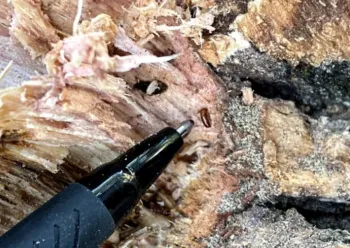The Mediterranean Oak Borer: a tiny threat to Marin’s majestic oaks

As you wander beneath Marin County’s stately white oaks, such as valley and blue oaks, be aware some little troublemakers are on the move. The Mediterranean oak borer (Xyleborus monographus), a beetle scarcely bigger than a peppercorn—about 3 millimeters long, or one-eighth of an inch—is quietly carving its way into our beloved oaks.
Where it came from and where it’s been found
This beetle hails from Europe, the Middle East, and North Africa—classic Mediterranean territory. It was first spotted in California in 2019 in Napa County. Since then, it has been reported in Lake, Sonoma, Mendocino, Sacramento, El Dorado, and Yolo counties—and as of May 2025, in Novato, here in Marin.
What trees it targets
The Mediterranean oak borer (MOB for short) mostly attacks native oaks, particularly valley oak (Quercus lobata) and blue oak (Quercus douglasii). It seems to prefer trees already stressed from drought, injury, or age. In some areas, black oaks have also been affected.
How it does its damage

MOB is a type of ambrosia beetle, and it doesn’t eat the wood itself. Instead, it bores into bark and lays eggs in tunnels called galleries. There, the beetle cultivates fungus—specifically, ambrosia fungi—which serves as food for both adult beetles and their larvae. The problem is that fungus spreads through the tree’s tissues, disrupting its ability to move water and nutrients. Over time, this fungal invasion, combined with damage from tunneling, can weaken and eventually kill the tree.
The beetle can produce two or more generations each year in California’s warm climate, so infestations can escalate quickly. The spread is accelerated by females flying to other trees.
Signs to watch for

Keep your eyes on the canopy. One of the earliest signs of MOB activity is a single branch that wilts or drops leaves while the rest of the tree looks fine. You might also notice fine sawdust collecting in bark crevices or on the ground below. Tiny, round exit holes—about the size of a pinhead—may appear on the bark, sometimes with dark staining or oozing sap.
If you cut into an infested branch or trunk, MOB galleries appear as tightly packed, fan-like or trellis-shaped tunnels—unlike the rounder or more scattered galleries left by native beetles.
What to do if you suspect it
If you think your tree might have MOB, don’t wait. Consult a certified arborist familiar with invasive pests.
Early detection matters, and proper handling of infested material is critical to slowing the spread. If a tree is confirmed to have MOB, the recommended steps include:
- Do not transport firewood—MOB larvae can hitch a ride to new areas.
- Chip infested wood into small pieces (1–3 inches).
- If chipping isn’t possible, burn the wood locally or cover it with soil to prevent the escape of beetles.
- Letting cut wood dry thoroughly in the sun can also kill larvae.
Research on chemical treatments are underway, including those to manage MOB and reduce fungal infection. Until treatment options are confirmed effective, prevention and sanitation are the key tools in the fight.
What can gardeners do?
The best way to protect your oaks is to keep them healthy and well-maintained. Avoid injuring tree trunks with tools. Mulch to preserve moisture and reduce root stress. Water deeply during dry spells, especially for young or vulnerable trees.
And most importantly, stay observant. Check your trees regularly, especially in late spring and early summer, when beetle activity is at its highest. If something looks off, consult an arborist.
The Mediterranean oak borer may be tiny, but with your help, we can keep Marin’s oaks standing tall. For more information, https://ucanr.edu/sites/default/files/2024-09/330538.pdf
By James Campbell, July 26, 2025
